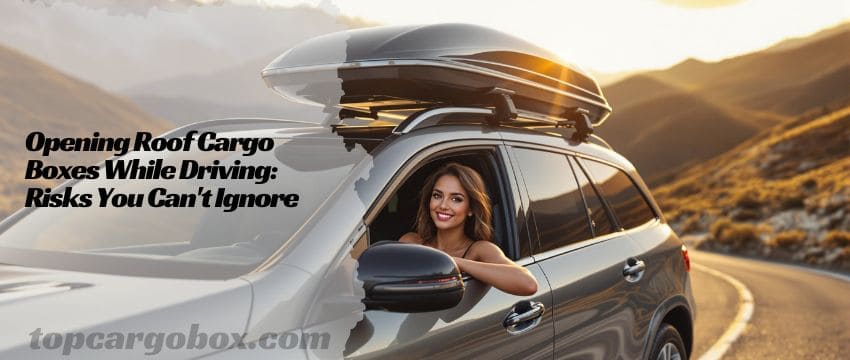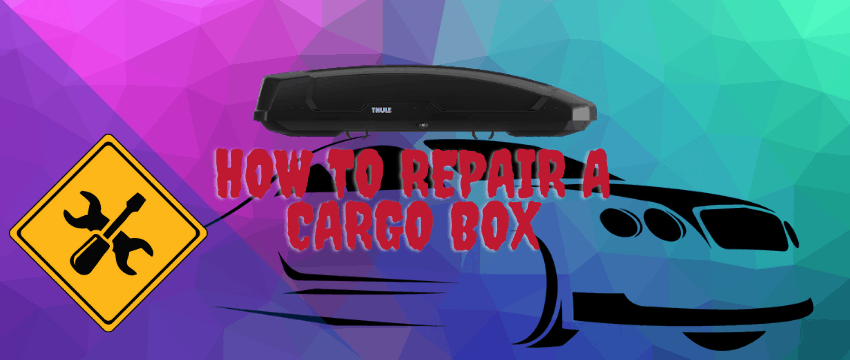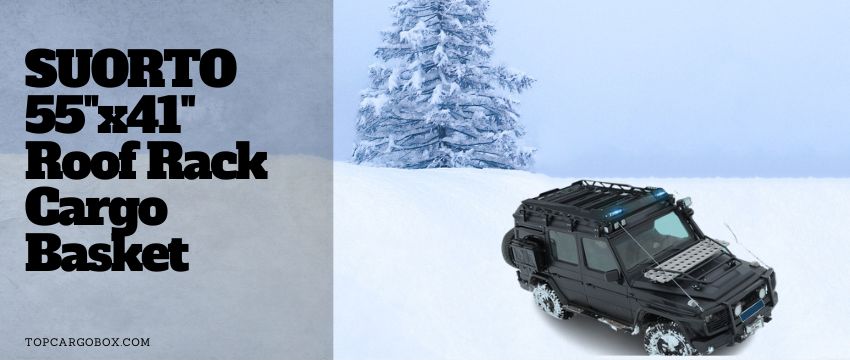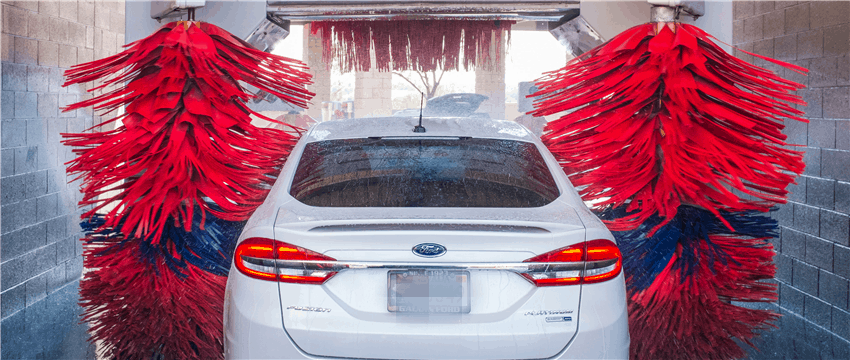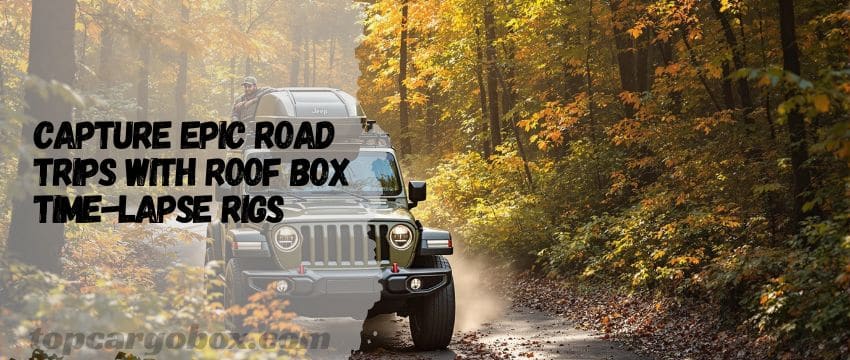What’s up, road trippers and adventure seekers? You’ve finally invested in that sweet roof cargo box, unlocking tons of extra space for gear, luggage, or maybe even the giant inflatable flamingo for the lake. It’s sitting up there, looking slick, and you’re cruising down the highway. Then it hits you – did you pack Aunt Marge’s fragile ceramic gnome collection near the bottom? The urge to just pop that box open while rolling might feel real strong. Hold up! Before you even think about unlatching that thing at 65 mph, let’s dive deep into why that’s a seriously bad idea wrapped in potential legal trouble. Trust me, this is one shortcut you absolutely don’t want to take.
The Immediate Dangers: Why It’s a Hard No
Seriously, opening your roof box while the car is moving is asking for trouble, and I’m not exaggerating. The forces involved when you’re speeding down the road are intense and totally unforgiving. Let’s break down exactly what makes it so dangerous.
What Happens When That Lid Flies Open?
Imagine cracking your box open even just a few inches. Instantly, you’ve created a massive air scoop hurtling through the wind. The aerodynamic chaos is nuts – that lid isn’t designed to handle those forces when partially open. It can violently rip right off its hinges, transforming from a handy storage unit into a terrifying, tumbling projectile. Can you picture a heavy, hard-shell box lid smashing into the windshield of the car behind you? That’s not just a fender bender; it’s potentially life-altering. The sheer physics involved make this outcome frighteningly likely.

Your Gear Takes Flight (Literally)
Okay, maybe you miraculously open it without the lid detonating. What’s inside isn’t staying put! The sudden rush of wind is like a hurricane blasting through your carefully packed items. Lighter stuff – jackets, sleeping bags, maybe that bag of chips – becomes instant confetti, flying out in a chaotic plume.
Heavier items shift violently, potentially smacking against the partially open lid or worse, tumbling out onto the road. Picture skis, coolers, or suitcases bouncing across lanes of traffic. It creates an instant, massive hazard for everyone around you, causing potential pile-ups or forcing dangerous evasive maneuvers. Your forgotten beach towel could cause a multi-car pileup – how awful is that?
You Lose Control (Big Time)
Here’s the kicker most folks don’t immediately consider: stability. Your car is carefully engineered for balance. Yanking open that roof box throws a massive wrench into its aerodynamics. It creates uneven drag and lift forces, making your vehicle feel unstable, pulling hard to one side, or even lifting slightly.
Ever driven past a big truck and felt your car get pushed? Multiply that by ten, unpredictably. Trying to wrestle control back while startled by flying gear and a flapping lid is a recipe for disaster. It takes split-second reactions you simply won’t have, potentially sending you off the road. Is grabbing that extra sweater really worth risking a rollover? No way!
The Legal Minefield: It’s Not Just Dangerous, It’s Often Illegal
Alright, so it’s clearly unsafe. But what about the law? Can you actually get busted for this? For real? Absolutely. While specific statutes vary, opening a roof box while driving likely violates multiple traffic laws almost everywhere. Let’s unpack the legal headaches waiting to happen.
Reckless Driving & Endangerment Charges
This is the big one. Police officers and prosecutors don’t need a specific “don’t open your roof box” law to nail you. Actions that show a “willful or wanton disregard for the safety of persons or property” fall under reckless driving. Knowingly opening a cargo box at speed, creating flying debris and a massive hazard? That textbook recklessness. Penalties are severe: hefty fines, license suspension, even jail time in extreme cases causing injury. Is that gnome collection worth a criminal record? Come on!
Obstructed Vision & Secured Load Violations
Think about your rearview mirror. A suddenly open roof box lid can completely block your view out the back window. Driving with an obstructed view is illegal in itself. Furthermore, every state has laws requiring cargo to be properly secured to prevent it from falling onto the roadway. Opening the box mid-drive guarantees your load is instantly unsecured and falling out – double violation! You could easily get ticketed for both offenses on top of reckless driving. That’s a triple whammy of fines and points on your license. Total bummer, dude.
Potential Liability in an Accident
Let’s say the absolute worst happens. Your flying lid or ejected gear causes an accident resulting in injuries, property damage, or worse. You are now legally and financially responsible. Insurance companies will investigate thoroughly. Evidence showing you opened the box while moving makes you clearly at fault. We’re talking about potentially devastating lawsuits that could financially cripple you for years. The liability is enormous and completely avoidable. Why risk your entire future over impatience? Hang tight and wait for a safe stop.
Why People Even Consider It (And Better Solutions)
Totally get why you’d ask the question! The urge usually stems from a sudden panic about what’s packed where or forgetting something crucial. Maybe you realize your meds are buried, or the kid’s favorite toy is inaccessible. The frustration is real when you’re miles from the next exit. But there are way smarter, safer hacks.
Smart Packing is Your First Defense
A little planning goes a crazy long way. Pack items you might need during the drive (snacks, medications, entertainment for kids, phone chargers, maybe an extra layer) in easy-access spots inside the car. Treat the roof box purely as overflow for stuff you definitely won’t need until you park – bulky luggage, camping gear, seasonal tires.
Use clear bins or packing cubes inside the roof box so you can quickly identify contents through the lid when stopped. Label everything clearly! Check out guides on packing your specific box, like tips for the Thule Motion 3 or maximizing space in a SportRack Vista XL. Off the top of my head, this simple step solves 99% of the “need to open it now” panic.
Choosing Boxes Designed for Easier Access
Not all cargo boxes are created equal! Some modern designs prioritize easier access when you are safely parked. Look for features like dual-side opening (so you don’t have to climb over the car), strut-assisted lids that stay open hands-free, and lower profiles. Boxes like the Yakima CBX 16 or Thule Force XT offer great accessibility features. While you still NEVER open them while moving, these features make quick stops much less of a hassle. Investing in accessibility saves you time and stress later.
The Only Safe Way: Pull Over!
This isn’t rocket science, but it’s the golden rule. If you absolutely must get into that roof box before your destination, find a safe, legal place to pull completely off the roadway. Think rest stops, wide highway shoulders (only if legal and safe!), or parking lots. Turn the engine off, engage the parking brake, then carefully open the box. Secure any loose items before closing and latching it properly. Yes, it takes a few extra minutes. But compared to the catastrophic risks of opening it while driving? No big deal at all. Your safety and others’ is worth that minor delay. Promise!
Driving Safely With a Roof Box (Even Closed!)
Alright, so we’ve slammed the door shut on opening it while moving. But just having a roof box up there changes your car’s dynamics. Let’s chat about driving smartly with that extra cargo on top.
Mind Your Speed and Space
Your car isn’t as agile or aerodynamic with a loaded roof box. Wind resistance increases significantly, affecting acceleration, braking, and fuel economy. Cruising at 75 mph with a box can feel like driving through molasses compared to without. More importantly, your stopping distance increases. Leave way more following room than usual – think double the space or more. Sudden stops require extra distance now. High crosswinds? Grip that steering wheel tighter; the box acts like a sail, making your car more susceptible to getting pushed around. Ease off the gas and stay focused.
Handling Corners and Curves
That weight up high raises your car’s center of gravity. Take corners, curves, and highway ramps much slower than you normally would. Pushing it risks body roll or, in extreme cases, a potential rollover. Brake before entering the curve, not during it. Smooth, gradual steering inputs are key. Feeling the car lean more than usual? That’s your cue to seriously dial back the speed. Better safe than sideways, right?
Regular Maintenance Checks are Non-Negotiable
Your roof box and rack system take a beating from wind, weather, and road vibrations. Make it a habit to check the mounting points, clamps, and box latches every single time you stop for gas or a break. A quick visual check takes seconds. Ensure all latches are securely closed before driving off. Periodically inspect the box for cracks or damage, and check the roof rack feet and crossbars for tightness and wear. A failure at speed is disastrous. Think of it like checking your tire pressure – essential routine stuff. See how different models like the Rhino-Rack MasterFit or Yakima SkyBox NX are designed for security.
What About Leaving the Box On?
So, you’re home from the trip. Can you just leave the box on the roof? Fair enough question! Many people do, especially if they use it frequently. But there are some things to consider for the long haul.
Security and Theft Concerns
An empty box sitting on your car is tempting for thieves, unfortunately. While they can be a grunt to remove without the key, determined thieves might still try, or worse, break into it hoping for valuables. If you live in a high-theft area or park on the street, removing it when not needed for an extended period is safer. Otherwise, at least ensure it’s always locked tight. Better safe than sorry, y’all.
Fuel Efficiency & Wear and Tear
Even empty, a roof box creates drag, hurting your gas mileage. We’re talking potentially 10-25% reduced MPG – ouch for your wallet! Leaving it on all the time means you’re constantly paying that fuel penalty. Plus, constant exposure to UV rays, rain, snow, and road grime accelerates wear on the box itself and the roof rack components. Taking it off extends the life of your gear. Feeling under the weather about that MPG hit? Taking it off helps!
When Removal Makes Sense
Definitely remove the box for long-term parking (like airport lots) or if you know you won’t need it for weeks or months. Seasonal users (like skiers or campers) often store it off-season. Folding options like the Mockins Folding Trailer Carrier are great for space-saving storage. If maximum fuel efficiency is crucial for your daily commute, take it off. It is what it is – convenience vs. cost and longevity.
Conclusion: Safety First, Every Single Time
Let’s wrap this up, friends. The question “Can you open a roof cargo box while driving?” has one crystal-clear answer: Absolutely not. No way, no how. The dangers of flying debris, ejected gear, loss of vehicle control, and causing catastrophic accidents are far too real and severe. It’s legit one of the riskiest things you could do on the road. Legally, it’s a fast track to reckless driving charges, hefty fines, and life-altering liability. Just forget it as an option.
The smart, safe play is all about preparation and patience. Pack thoughtfully, invest in an accessible box if needed, and always, always pull over completely to a safe spot if you absolutely must access it mid-journey. Drive cautiously with the box, respecting the changes to your vehicle’s handling and braking. Your adventures are meant to be awesome memories, not nightmares. By respecting the power of physics and the rules of the road, you ensure everyone gets to their destination safely. Now get out there, explore, and keep that roof box latched tight until you park! Take it easy on the road.
Our team is creating outdoor-gear relevant articles with passion. If our articles can help you to find the correct solutions for your questions, we will be happy about that. In the content creation process, we usually collect accurate and useful information online or offline to compile our content in an organized way. Consequently, we can guarantee that you can discover some expected answers to your questions. We appreciate your time on our site.

